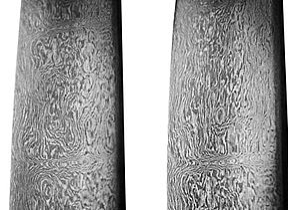- Home
- About US
- Art and Craft
- Artisans
- Master Crafts Persons
- Supporting Institutions
- News and Events
- Schemes
- Contact us
- Contact

Damascus Steel was a type of steel used for manufacturing sword blades in the Near East made with wootz steel imported from Southern India. These swords are characterized by distinctive patterns of banding and mottling reminiscent of flowing water. Such blades were reputed to be tough, resistant to shattering and capable of being honed to a sharp, resilient edge.
The steel is named after Damascus, the capital city of Syria. It may either refer to swords made or sold in Damascus directly, or it may just refer to the aspect of the typical patterns, by comparison withDamask fabrics (which are in turn named after Damascus).
The original method of producing Damascus steel is not known. Modern attempts to duplicate the metal have not been entirely successful due to differences in raw materials and manufacturing techniques. Several individuals in modern times have claimed that they have rediscovered the methods by which the original Damascus steel was produced.
The reputation and history of Damascus steel has given rise to many legends, such as the ability to cut through a rifle barrel or to cut a hair
falling across the blade. Although certain types of modern steel outperform these swords, chemical reactions in the production process made the blades extraordinary for their time, as Damascus steel was superplastic and very hard at the same time. During the smelting process to obtain Wootz steel ingots, woody biomass and leaves are known to have been used as carburizing additives along with certain specific types of iron rich in microalloying elements. These ingots would then be further forged and worked into Damascus steel blades, and research now shows that carbon nanotubes can be derived from plant fibers, suggesting how the nanotubes were formed in the steel. Some experts expect to discover such nanotubes in more relics as they are analyzed more closely.
Loss Of The Technique-Production of these patterned swords gradually declined, ceasing by around 1750, and the process was lost to metalsmiths. Several modern theories have ventured to explain this decline, including the breakdown of trade routes to supply the needed metals, the lack of trace impurities in the metals, the possible loss of knowledge on the crafting techniques through secrecy and lack of transmission, suppression of the industry in India by the British Raj, or a combination of all the above.
The original Damascus steel or wootz was imported from India to Damascus, where bladesmiths learned how to forge them into swords. Due to the distance of trade for this steel, a sufficiently lengthy disruption of the trade routes could have ended the production of Damascus steel and eventually led to the loss of the technique in India. As well, the need for key trace impurities of tungsten or vanadium within the materials needed for production of the steel may be absent if this material was acquired from different production regions or smelted from ores lacking these key trace elements. The technique for controlled thermal cycling after the initial forging at a specific temperature could also have been lost, thereby preventing the final damask pattern in the steel from occurring.
The discovery of carbon nanotubes in the Damascus steel's composition supports this hypothesis, since the precipitation of carbon nanotubes probably resulted from a specific process that may be difficult to replicate should the production technique or raw materials used be significantly altered.

